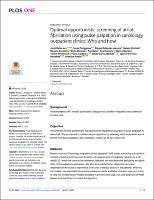Optimal opportunistic screening of atrial fibrillation using pulse palpation in cardiology outpatient clinics: Who and how
Author
Date
2022-04-21Permanent link
https://hdl.handle.net/11351/8041DOI
10.1371/journal.pone.0266955
ISSN
1932-6203
WOS
000795468200067
PMID
35446875
Abstract
Background
Atrial fibrillation (AF) remain a prevalent undiagnosed condition frequently encountered in primary care.
Objective
We aimed to find the parameters that optimize the diagnostic accuracy of pulse palpation to detect AF. We also aimed to create a simple algorithm for selecting which individuals would benefit from pulse palpation and, if positive, receive an ECG to detect AF.
Methods
Nurses from four Cardiology outpatient clinics palpated 7,844 pulses according to a randomized list of arterial territories and durations of measure and immediately followed by a 12-lead ECG, which we used as the reference standard. We calculated the sensitivity and specificity of the palpation parameters. We also assessed whether diagnostic accuracy depended on the nurse’s experience or on a list of clinical factors of the patients. With this information, we estimated the positive predictive values and false omission rates according to very few clinical factors readily available in primary care (age, sex, and diagnosis of heart failure) and used them to create the algorithm.
Results
The parameters associated with the highest diagnostic accuracy were palpation of the radial artery and classifying as irregular those palpations in which the nurse was uncertain about pulse regularity or unable to palpate pulse (sensitivity = 79%; specificity = 86%). Specificity decreased with age. Neither the nurse’s experience nor any investigated clinical factor influenced diagnostic accuracy. We provide the algorithm to select the ≥40 years old individuals that would benefit from a pulse palpation screening: a) do nothing in <60 years old individuals without heart failure; b) do ECG in ≥70 years old individuals with heart failure; c) do radial pulse palpation in the remaining individuals and do ECG if the pulse is irregular or you are uncertain about its regularity or unable to palpate it.
Conclusions
Opportunistic screening for AF using optimal pulse palpation in candidate individuals according to a simple algorithm may have high effectiveness in detecting AF in primary care.
Keywords
Nurses; Primary care; Heart failureBibliographic citation
Bañeras J, Pariggiano I, Ródenas-Alesina E, Oristrell G, Escalona R, Miranda B, et al. Optimal opportunistic screening of atrial fibrillation using pulse palpation in cardiology outpatient clinics: Who and how. PLoS One. 2022 Apr 21;17(4):e0266955.
Audience
Professionals
This item appears in following collections
- HVH - Articles científics [4476]
- VHIR - Articles científics [1751]
The following license files are associated with this item:

 Private area
Private area Contact Us
Contact Us








